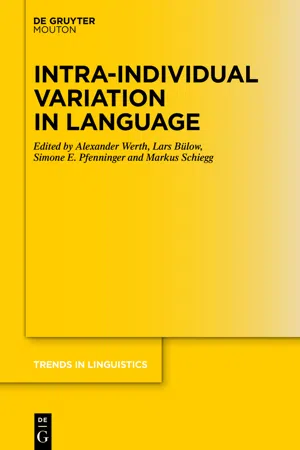
Intra-individual Variation in Language
- 417 pages
- English
- ePUB (mobile friendly)
- Available on iOS & Android
Intra-individual Variation in Language
About This Book
This volume offers several empirical, methodological, and theoretical approaches to the study of observable variation within individuals on various linguistic levels. With a focus on German varieties, the chapters provide answers on the following questions (inter alia):
Which linguistic and extra-linguistic factors explain intra-individual variation? Is there observable intra-individual variation that cannot be explained by linguistic and extra-linguistic factors? Can group-level results be generalised to individual language usage and vice versa? Is intra-individual variation indicative of actual patterns of language change? How can intra-individual variation be examined in historical data?
Consequently, the various theoretical, methodological and empirical approaches in this volume offer a better understanding of the meaning of intra-individual variation for patterns of language development, language variation and change.
The inter- and transdisciplinary nature of the volume is an exciting new frontier, and the results of the studies in this book provide a wealth of new findings as well as challenges to some of the existing findings and assumptions regarding the nature of intra-individual variation.
Frequently asked questions
Information
Part I: Phonetic-phonological dimension
Everyone Is Different, So Everyone Is the Same – Intra-individual Variation in Second Language Acquisition
Abstract
1 Introduction
Table of contents
- Title Page
- Copyright
- Contents
- Introduction
- What Is Intra-individual Variation in Language?
- Part I: Phonetic-phonological dimension
- Part II: Syntactic-morphological dimension
- Part III: Historical dimension
- Index